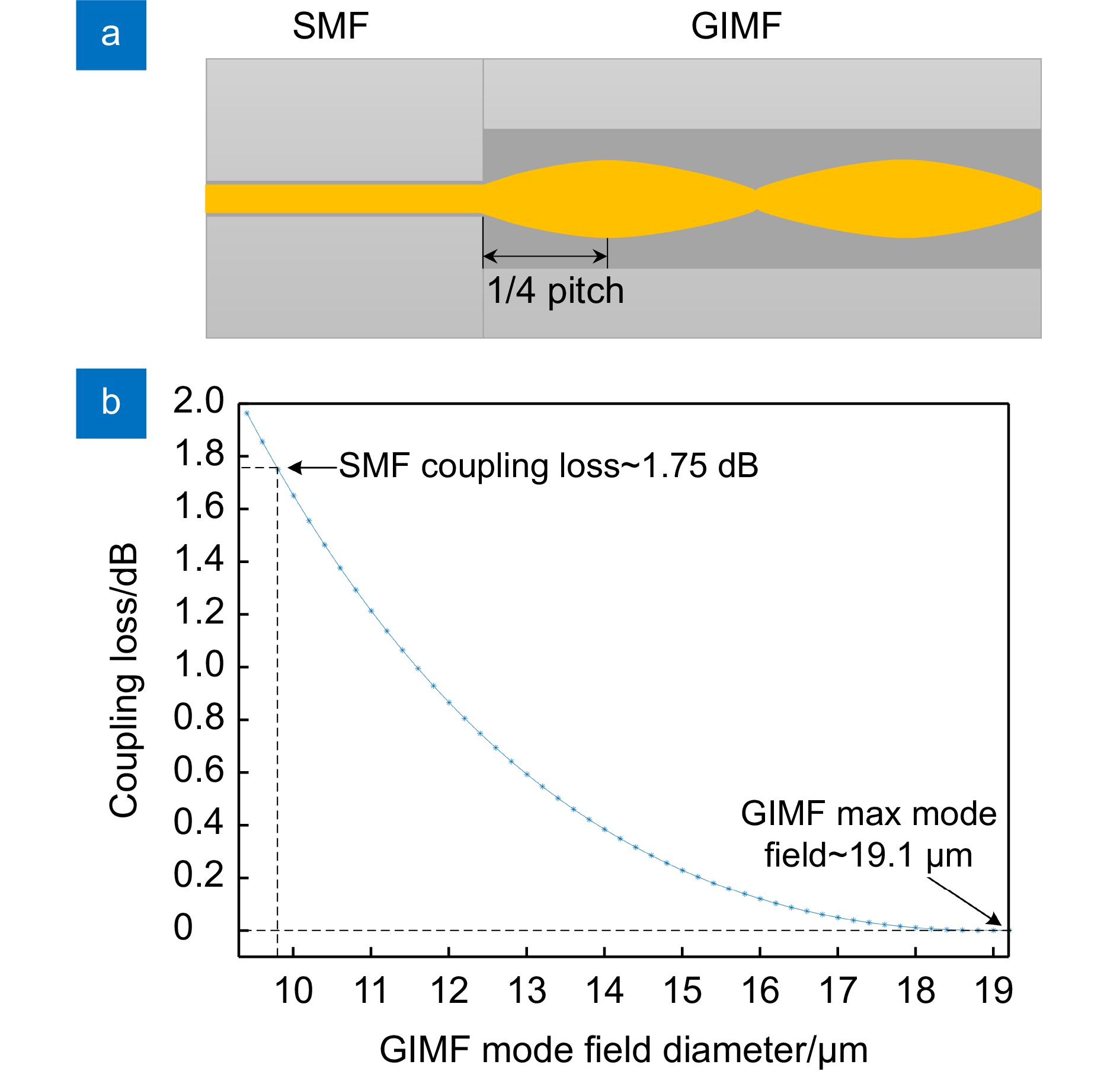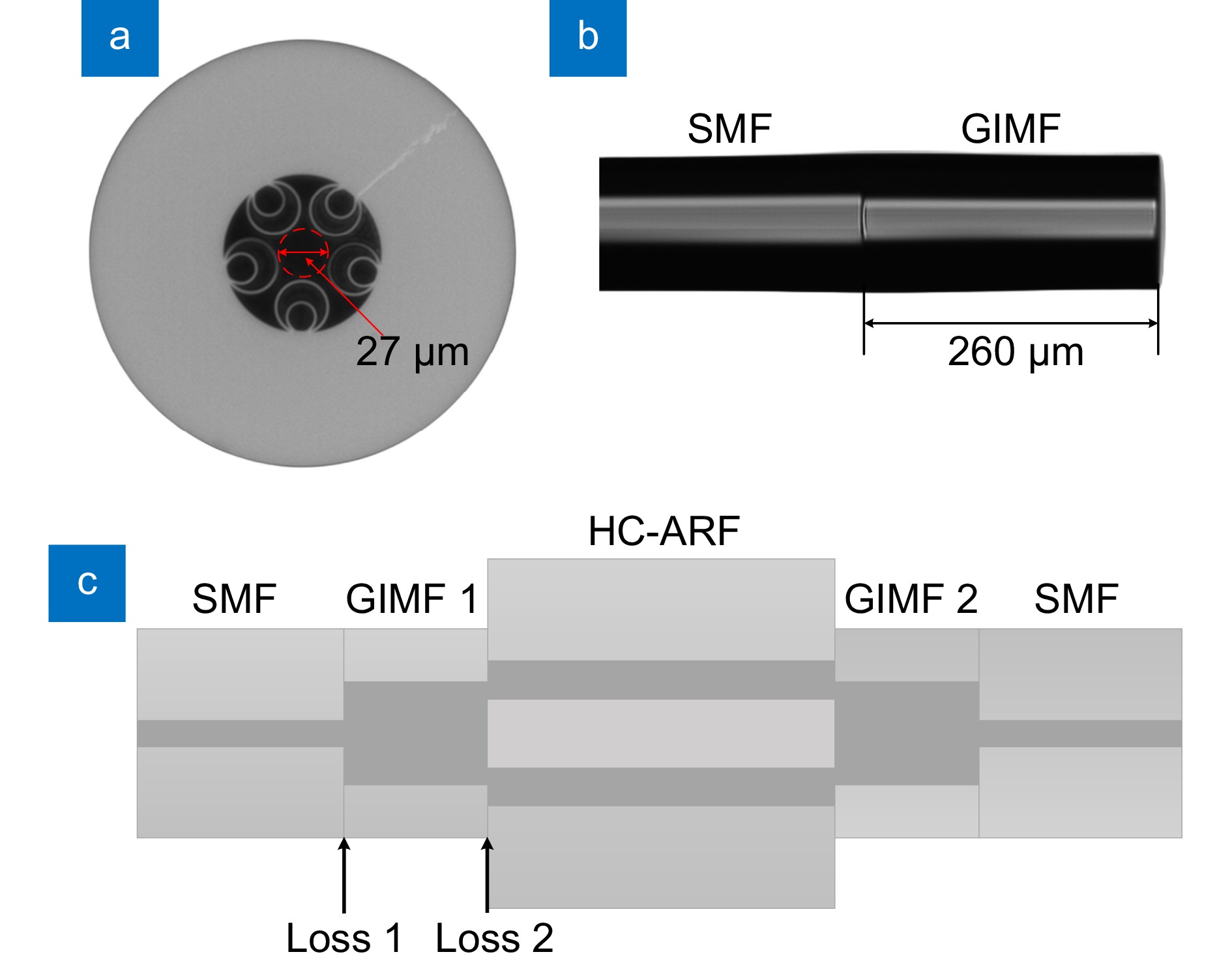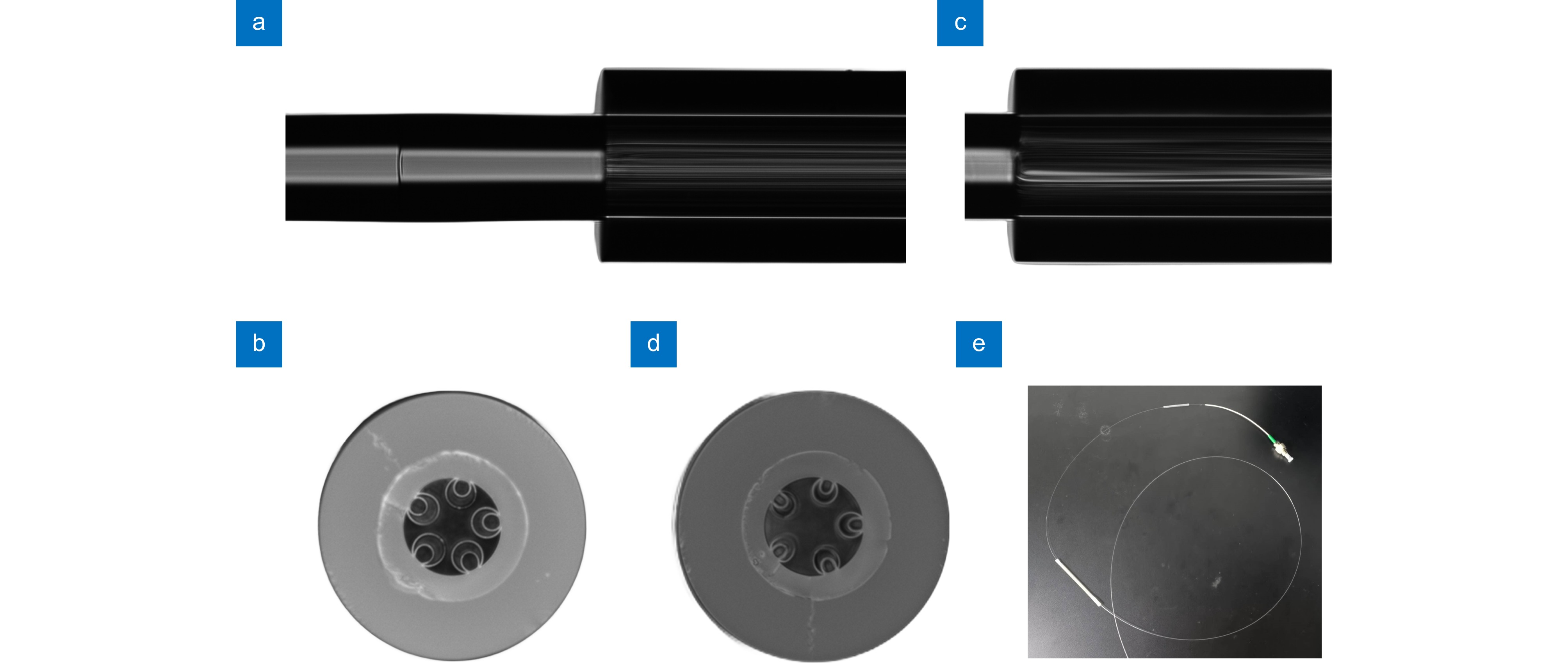Low-loss fusion splice of hollow-core anti-resonant fiber and single mode fiber based on GIMF
-
摘要:
本文提出了一种引入渐变折射率多模光纤作为过渡光纤的嵌套空芯反谐振光纤与单模光纤的低损耗熔接方法。使用渐变折射率多模光纤作为模场适配光纤,利用其自成像效应扩大单模光纤中的模场,实现了嵌套空芯反谐振光纤与单模光纤的模场匹配。实验中探究了熔接时放电时间和放电功率对熔接损耗的影响。基于优化后的熔接方案,有效保护了嵌套空芯反谐振光纤熔接端面微结构的完整性,平均熔接损耗低至0.60 dB。实验结果对提高嵌套空芯反谐振光纤与现有光纤体系的兼容性提供了参考。
Abstract:This paper presents a low-loss fusion splice method between the nested hollow-core anti-resonant fiber (HC-ARF) and single-mode fiber (SMF) by introducing a graded-index multi-mode fiber (GIMF) as a transition fiber. The mode field matching between the nested HC-ARF and the SMF is achieved by using the GIMF as the mode field adapting fiber and expanding the mode field in the SMF by using its self-imaging effect. The effects of discharge time and discharge power on fusion splice loss during fusion splicing are explored in the experiments. Based on an optimized fusion splicing scheme, the integrity of the microstructure of the nested HC-ARF fusion splicing end face is effectively protected, and the average fusion splicing loss is as low as 0.60 dB. The experimental results provide a reference to improve the compatibility of the nested hollow-core anti-resonant fibers with the existing fiber system.
-
Overview: Hollow core anti-resonant fiber (HC-ARF) is a type of fiber with a novel optical guiding mechanism. Compared with traditional single-mode fiber (SMF), HC-ARF has the advantages of lower dispersion, nonlinearities, Rayleigh scattering, higher propagation speed, and damage threshold. It has great potential applications in fiber sensing, high-power transmission, gas laser, mid-infrared laser, and other fields. In recent years, the interconnection methods between SMF and HCF mainly include fiber array connection based on adhesive bonding, connector connection, and fiber array fusion splicing. However, these methods all have certain limitations, such as complex operations and insufficient stability. To address these issues, we introduced a precisely controlled length graded-index multi-mode fiber (GIMF) as a transition fiber in the fusion splicing of HC-ARF and SMF, achieving mode field matching between HC-ARF and SMF.
The main sources of fusion losses between HC-ARF and SMF include microstructure collapse of the fusion end face of HC-ARF, mode field mismatch between the two fibers, geometric offset during fiber alignment, and flatness of the fiber end face. The mode field mismatch loss between HC-ARF and SMF is due to their different mode field diameters. For the fusion splicing of HC-ARF and SMF, a transition fiber needs to be added to achieve mode field matching between the two fibers.
The HC-ARF used for fusion splicing is an anti-resonant structure with five nested tubes. The loss of direct fusion splicing between SMF and HC-ARF (with the intact microstructure of HC-ARF) can even exceed 3 dB. Use a regular fiber fusion splicer to fuse SMF and GIMF in multimode fiber fusion mode, and then precisely control the length of 260 μm cutting. The effects of discharge time and discharge power on fusion splicing loss during fusion splicing were also investigated in the experiment. The fusion splicing strength should be maximized while ensuring the integrity of the microstructure of the nested HC-ARF end faces during fusion splicing. A C+L band amplified spontaneous emission (ASE) light source with a wavelength of 1520-1620 nm is used to measure losses. The measured overall loss is 1.19 dB. The results of multiple fusion splicing experiments indicate that the length of GIMF fiber has a significant impact on the loss. The optimal length of GIMF fiber should be around 260-270 μm. If the cutting error of GIMF is further optimized, low-loss fusion splicing results can be obtained more stably. This work provides useful guidance for improving the compatibility between HC-ARF and existing fiber optic systems, and can serve as the technical foundation for the development and application of HC-ARF.
-

-
图 2 嵌套HC-ARF与光纤阵列熔接。(a)嵌套HC-ARF端面结构图;(b)熔接与定长切割后的SMF-GIMF;(c) SMF-GIMF-(HC-ARF)-GIMF-SMF构型以及熔接点损耗示意图
Figure 2. Nested HC-ARF and fiber arrays fusion splice. (a) Nested HC-ARF end face structure diagram; (b) SMF-GIMF after fusion splice and fixed length cleave; (c) SMF-GIMF-(HC-ARF)-GIMF-SMF configuration and diagram of fusion splice point loss
图 4 熔接结果。(a)熔接后的SMF-GIMF-(HC-ARF)光纤;(b)拉断熔接点后的HC-ARF端面;(c) HC-ARF变形坍缩侧面;(d) HC-ARF变形的端面;(e)用热缩套管保护的光纤
Figure 4. Result of fusion splice. (a) SMF-GIMF-(HC-ARF) after fusion splice; (b) HC-ARF end face after breaking the fusion splice point; (c) Side view of HC-ARF collapse; (d) End face of HC-ARF collapse; (e) Fiber protected by heat shrink tubing
表 1 不同角度熔接测试的熔接损耗
Table 1. Loss from different angle fusion splice tests
Sample GIMF length/μm GIMF angle/(°) HC-ARF angle/(°) Loss/dB 1 268 0.7 0.2 0.56 2 270 1.0 0.8 1.27 3 272 1.1 0.1 0.74 4 268 1.2 0.1 0.80 5 267 1.3 0.2 0.73 6 270 1.5 0.1 0.70 7 270 2.1 0.3 0.99 表 2 多次熔接测试的熔接损耗
Table 2. Loss from multiple fusion splice tests
Sample GIMF1 length/μm GIMF1 loss/dB GIMF2 length/μm GIMF2 loss/dB Total loss/dB 1 290 0.93 272 0.95 1.88 2 267 0.44 276 1.05 1.49 3 265 0.47 268 0.75 1.22 4 267 0.45 265 0.74 1.19 -
[1] Roberts P J, Couny F, Sabert H, et al. Ultimate low loss of hollow-core photonic crystal fibres[J]. Opt Express, 2005, 13(1): 236−244. doi: 10.1364/OPEX.13.000236
[2] Jasion G T, Sakr H, Hayes J R, et al. 0.174 dB/km hollow core double nested antiresonant nodeless fiber (DNANF)[C]//2022 Optical Fiber Communications Conference and Exhibition (OFC), San Diego, 2022: 1–3.
[3] 李萍, 陈伟. 空芯反谐振光纤长距离通信的机遇与挑战[J]. 光通信研究, 2023(2): 1−8, 44. doi: 10.13756/j.gtxyj.2023.02.001
Li P, Chen W. Opportunity and challenge for hollow core anti resonant optical fiber in the long-distance telecommunication[J]. Study Opt Commun, 2023(2): 1−8, 44. doi: 10.13756/j.gtxyj.2023.02.001
[4] Poletti F. Nested antiresonant nodeless hollow core fiber[J]. Opt Express, 2014, 22(20): 23807−23828. doi: 10.1364/OE.22.023807
[5] Perevoschikov S, Kaydanov N, Ermatov T, et al. Light guidance up to 6.5 µm in borosilicate soft glass hollow-core microstructured optical waveguides[J]. Opt Express, 2020, 28(19): 27940−27950. doi: 10.1364/OE.399410
[6] Peng X, Mielke M, Booth T. High average power, high energy 1.55 μm ultra-short pulse laser beam delivery using large mode area hollow core photonic band-gap fiber[J]. Opt Express, 2011, 19(2): 923−932. doi: 10.1364/OE.19.000923
[7] 张博, 顾帅, 廉正刚, 等. 微结构空芯光纤特性及光纤测试和工程应用[J]. 光通信研究, 2023(2): 9−18, 68. doi: 10.13756/j.gtxyj.2023.02.002
Zhang B, Gu S, Lian Z G, et al. The characteristics and fiber test of micro-structure hollow core fiber and its engineering application[J]. Study Opt Commun, 2023(2): 9−18, 68. doi: 10.13756/j.gtxyj.2023.02.002
[8] Sollapur R, Kartashov D, Zürch M, et al. Resonance-enhanced multi-octave supercontinuum generation in antiresonant hollow-core fibers[J]. Light Sci Appl, 2017, 6(12): e17124. doi: 10.1038/lsa.2017.124
[9] Wang Y Z, Dasa M K, Adamu A I, et al. High pulse energy and quantum efficiency mid-infrared gas Raman fiber laser targeting CO2 absorption at 4.2 µm[J]. Opt Letters, 2020, 45(7): 1938−1941. doi: 10.1364/OL.389613
[10] 陈天航, 于晶, 朱晓松, 等. 渐变型柔性空芯光纤吸收腔的气体传感特性[J]. 光通信研究, 2017(2): 36−39. doi: 10.13756/j.gtxyj.2017.02.011
Chen T H, Yu J, Zhu X S, et al. Characterization of gas sensing system with gradually tapered flexible hollow waveguides as absorption cell[J]. Study Opt Commun, 2017(2): 36−39. doi: 10.13756/j.gtxyj.2017.02.011
[11] Zhao P C, Zhao Y, Bao H H, et al. Mode-phase-difference photothermal spectroscopy for gas detection with an anti-resonant hollow-core optical fiber[J]. Nat Commun, 2020, 11(1): 847. doi: 10.1038/s41467-020-14707-0
[12] Wang Z F, Belardi W, Yu F, et al. Efficient diode-pumped mid-infrared emission from acetylene-filled hollow-core fiber[J]. Opt Express, 2014, 22(18): 21872−21878. doi: 10.1364/OE.22.021872
[13] Xiao L M, Demokan M S, Jin W, et al. Fusion splicing photonic crystal fibers and conventional single-mode fibers: microhole collapse effect[J]. J Lightwave Technol, 2007, 25(11): 3563−3574. doi: 10.1109/JLT.2007.907787
[14] Suslov D, Komanec M, Fokoua E R N, et al. Low loss and high performance interconnection between standard single-mode fiber and antiresonant hollow-core fiber[J]. Sci Rep, 2021, 11(1): 8799. doi: 10.1038/s41598-021-88065-2
[15] Zhang Z, Jia A Q, Hong Y F, et al. Ultralow-loss, plug-and-play hollow-core fiber interconnection[C]//2022 Optical Fiber Communications Conference and Exhibition (OFC), San Diego, 2022: 1–3.
[16] Gao S F, Wang Y Y, Tian C P, et al. Splice loss optimization of a photonic bandgap fiber via a high V-number fiber[J]. IEEE Photonics Technol Lett, 2014, 26(21): 2134−2137. doi: 10.1109/LPT.2014.2349519
[17] Wang C Y, Yu R W, Xiao L M. Low-loss fusion splicing between antiresonant-HCFs and AR-coated SMFs with low return loss[C]//2022 Asia Communications and Photonics Conference (ACP), Shenzhen, 2022: 280–282. https://doi.org/10.1109/ACP55869.2022.10089113.
[18] Zhang C, Fokoua E N, Fu S N, et al. Low loss and back-reflection interconnection between SMF and hollow core fiber by angled fusion splicing[C]//2022 Conference on Lasers and Electro-Optics (CLEO), San Jose, 2022: 1–2.
[19] Shi B, Zhang C, Fokoua E R N, et al. Towards spliced SMF to hollow core fiber connection with low loss and low back-reflection[C]//2023 Conference on Lasers and Electro-Optics (CLEO), San Jose, 2023: 1–2.
[20] Zhong A L, Fokoua E N, Ding M, et al. Connecting hollow-core and standard single-mode fibers with perfect mode-field size adaptation[J]. J Lightwave Technol, 2024, 42(6): 2124−2130. doi: 10.1109/JLT.2023.3329738
[21] Komanec M, Suslov D, Zvanovec S, et al. Low-loss and low-back-reflection hollow-core to standard fiber interconnection[J]. IEEE Photonics Technol Lett, 2019, 31(10): 723−726. doi: 10.1109/LPT.2019.2902635
[22] 张乃千, 秦天令, 王泽锋, 等. 反共振空芯光子晶体光纤与拉锥光纤低损耗耦合[J]. 激光与光电子学进展, 2017, 54(10): 100608. doi: 10.3788/LOP54.100608
Zhang N Q, Qin T L, Wang Z F, et al. Low-loss coupling between tapered fibers and anti-resonant hollow-core photonic crystal fibers[J]. Laser Optoelectron Prog, 2017, 54(10): 100608. doi: 10.3788/LOP54.100608
[23] 李晓倩, 高寿飞, 汪滢莹, 等. 空芯反谐振光纤与单模光纤的低损耗熔接研究[J]. 光学学报, 2018, 38(10): 1006002. doi: 10.3788/AOS201838.1006002
Li X Q, Gao S F, Wang Y Y, et al. Low-loss fusion splice of hollow-core anti-resonant fiber and single mode fiber[J]. Acta Opt Sin, 2018, 38(10): 1006002. doi: 10.3788/AOS201838.1006002
[24] Marcuse D. Loss analysis of single-mode fiber splices[J]. Bell Syst Tech J, 1977, 56(5): 703−718. doi: 10.1002/j.1538-7305.1977.tb00534.x
[25] Hofmann P, Mafi A, Jollivet C, et al. Detailed investigation of mode-field adapters utilizing multimode-interference in graded index fibers[J]. J Lightwave Technol, 2012, 30(14): 2289−2298. doi: 10.1109/JLT.2012.2196406
[26] Zuba V, Mulvad H C H, Slavík R, et al. Limits of coupling efficiency into hollow-core antiresonant fibres[J]. J Lightwave Technol, 2023, 41(19): 6374−6382. doi: 10.1109/JLT.2023.3279701
-


 E-mail Alert
E-mail Alert RSS
RSS

 下载:
下载:







